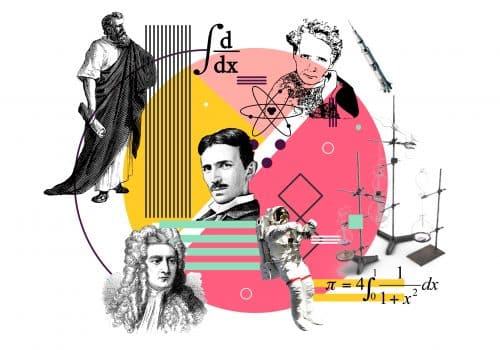Long before philosophy and physics split into separate career paths, the natural philosophers of Ancient Greece speculated about the basic components from which all else is made. Plato entertained a theory on which everything on Earth is made from four fundamental particles. There are stable cube-shaped particles of earth, pointy and painful tetrahedron-shaped particles of fire, somewhat less pointy octahedron-shaped particles of air, and reasonably round icosahedron-shaped particles of water. Like the particles of contemporary physics, Plato thought it was possible for these particles to be created and destroyed. For example, an eight-sided air particle could be created by combining two four-sided fire particles (as one might imagine occurring when a campfire dies out).
Our understanding of nature has come a long way since Plato. We have learned that much of our world is made of the various atoms compiled in the periodic table of elements. We have also learned that atoms themselves are built from more fundamental pieces.
Today, philosophers who are interested in figuring out what everything is made of look to contemporary physics for answers. But, finding answers in physics is not simply a matter of reading textbooks. Physicists deftly shift between different pictures of reality as it suits the task at hand. The textbooks are written to teach you how to use the mathematical tools of physics most effectively, not to tell you what things the equations are describing. It takes hard work to distil a story about what’s really happening in nature from the mathematics. This kind of research is considered ‘philosophy of physics’ when done by philosophers and ‘foundations of physics’ when done by physicists.
Physicists have developed an improvement on the periodic table called ‘the standard model’. The standard model is missing something very important (gravity) and it might turn out that the pieces it describes are made of yet more fundamental things (such as vibrating strings). That being said, the standard model is not going anywhere. Like Isaac Newton’s theory of gravity or James Clerk Maxwell’s theory of electrodynamics, we expect that the standard model will remain an important part of physics no matter what happens next.
Unfortunately, it’s not immediately clear what replaces the atoms of the periodic table in the standard model. Are the fundamental building blocks of reality quantum particles, quantum fields, or some combination of the two? Before tackling this difficult question, let us consider the debate between particles and fields in the context of a classical (non-quantum) theory: Maxwell’s theory of electrodynamics.
Albert Einstein was led to his 1905 special theory of relativity by engaging in foundational research on electrodynamics. After developing special relativity, Einstein entered into a debate with Walther Ritz about the right way to formulate and understand classical electrodynamics. According to this theory, two electrons placed near one another will fly apart in opposite directions. They both have negative charge, and they will thus repel one another.
Ritz thought of this as an interaction directly between the two electrons – each one pushing the other, even though they are not touching. This interaction acts across the gap in space separating the two electrons. It also acts across a gap in time. Being precise, each electron responds to the other’s past behaviour (not its current state).
Einstein, who was averse to such action-at-a-distance, understood this interaction differently. For him, there are more players on the scene than just the particles. There are also fields. Each electron produces an electromagnetic field that extends throughout space. The electrons move away from one another not because they are directly interacting with each other across a gap, but because each one is feeling a force from the other’s field.
Do electrons feel forces from their own electromagnetic fields? Either answer leads to trouble. First, suppose the answer is yes. The electromagnetic field of an electron gets stronger as you get closer to the electron. If you think of the electron as a little ball, each piece of that ball would feel an enormous outward force from the very strong electromagnetic field at its location. It should explode. Henri Poincaré conjectured that there might be some other forces resisting this self-repulsion and holding the electron together – now called ‘Poincaré stresses’. If you think of the electron as point-size, the problem is worse. The field and the force would be infinite at the electron’s location.














